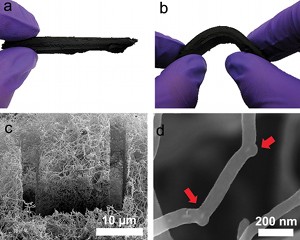
A carbon nanotbue sponge developed with help from Oak Ridge National Laboratory researchers could be used to help clean up oil. (Photo submitted by ORNL)
A team that includes researchers from Oak Ridge National Laboratory has developed a carbon nanotube sponge that can soak up oil in water.
The sponge could be used to help clean up oil spills, an ORNL press release said.
It was developed with help from computational simulations performed at the lab.
Carbon nanotubes consist of atom-thick sheets of carbon rolled into cylinders.
Experiments have shown that the research team’s material, which is visible to the human eye, is effective at absorbing oil in contaminated seawater because it attracts oil and repels water.
“It loves carbon because it is primarily carbon,” said ORNL’s Bobby Sumpter.
“Depending on the density of oil-to-water content and the density of the sponge network, it will absorb up to 100 times its weight in oil.”
Sumpter was part of a multi-institutional research team that set out to grow large clumps of nanotubes by selectively substituting boron atoms into the otherwise pure carbon lattice, the press release said.
The materials’ mechanical flexibility, magnetic properties, and strength make it a potential aid in oil spill cleanup.
“You can reuse the material over and over again because it’s so robust,” Sumpter said.
Its magnetic properties mean that it can be easily controlled or removed with a magnet in an oil cleanup scenario. This is an improvement over existing treatments used in oil removal, which are often left behind after cleanup and can degrade the environment.
Besides ORNL, the developers include researchers from Rice University, Air Force Office of Scientific Research Laboratory, University of Illinois at Urbana-Champaign, and many others.





Leave a Reply